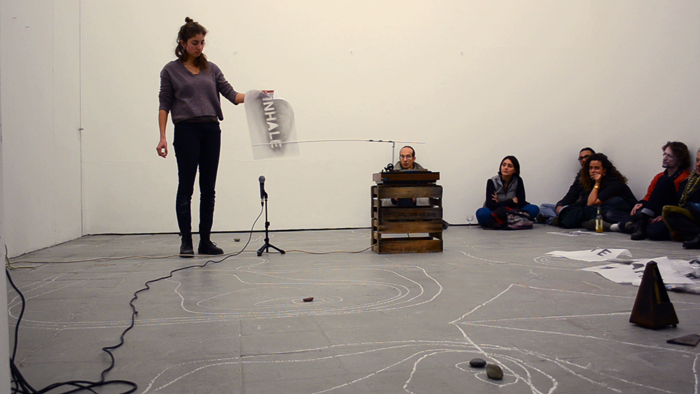Genealogies
- + BrowseBrowse →
- Home
Genealogies is a body of works that considers diverse representations of genealogy as an attempt to fix and retrace one’s history and heritage. It aims to research - in a series of performative actions and written works - what remains invisible from memory transmission in these essentially fixed representations. A face off with ideas of the linear nature of heritage and notion of predestination.
In the performances, elements such as wooden sticks, water, soil, chalk, written words are assembled in ephemeral live installations through the action of my body and voice. I use anagrams as scores during the performances: the rearrangement of letters of fixed words and sentences for the creation of new poetic meanings.
My research on anagrams as score writing led me to a new collaborative work with musician Till Baumann called Breathe in which the action of breathing as a form of mantra to measure inner emotion and prevent fear for the future. Poems and anagrams are assembled live while the repetitive aspect of breath is used for the production of sonic, rhythmical images.
Solo Performance: Genealogies
For 3am, Spring Sprouts
at Flutgraben, Berlin
March 2017
Photo credit: Fanni Udvarnoki









with Till Baumann
in: "Faith and Terror" performance art festival in Meinblau, Berlin
curated by Anne Hoelck and Tristan Deschamps
November 2016.
Invited by the performance festival Faith &Terror, the Ritournelle Performance Breathe focusses on the action of breathing as a form of mantra to measure inner emotion. Poems and anagrams are created live while the repetitive aspect of breath is used for the production of sonic, rhythmical images.
With Ritournelle, Anais Héraud and Till Baumann managed to nudge me from peace to nightmare and back again. Sheets of paper flutter through the air, telling us to inhale and exhale. In the back a plastic pole circles horizontally on what looks like a modified record player, while a metronome ticks in the front. Ticking, circling, breathing — the three rhythms don’t align, but they lull me into a meditative peace. Then, slowly, the logic becomes darker, Héraud loses herself in the repetition of a phrase, pulling other words out of it as anagrams. It’s not quite terror, but it does have something of the inescapable self-reference of a dream. Dan O'Huiginn




